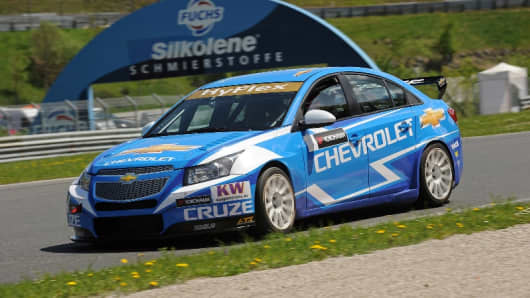The auto industry has been actively involved in racing since the earliest days of the automobile. In fact, Henry Ford got backers to finance his company after winning a race in one of his prototypes. The Chevrolet brand, meanwhile, was original created by racer Louis Chevrolet.
And ever since, contends Campbell, a former Chevy general manager, the brand and its sibling GM divisions have counted on racing to "improve the breed."
(Read More: Tesla Pays Off $465 Million DOE Loan)
The Corvette is a great example. Its 6.2-liter V-8 uses direct injection to achieve the seemingly contradictory needs of increasing power while also boosting fuel economy. GM first tried DI technology on the track. The same is true for the super-strong and ultra-light carbon fiber panels used for the Stingray's roof and hood.
"It's all about technology transfer," GM's racing chief explained. But he quickly adds another benefit. "It's also a great place to train our engineers in an environment that's very demanding and very fast paced."
Where an automaker might take years to find ways to boost the performance of a new engine sold through its showrooms, it may have days to achieve the same results if it hopes to be competitive on the track.
Of course, there's yet another advantage to a successful program. The old industry adage is "Win on Sunday, Sell on Monday." But industry marketers have been trying to do even better, using social media and other efforts to draw race fans into showrooms every day of the week.
(Read More From the Detroit Bureau: Detroit Automakers Struggle to Meet Booming Sales, Cut Short Summer Shutdown)
Mazda is betting that its new endurance racing program will both focus attention on its new SkyActiv-D diesel engine—and reveal ways to improve the technology, which will be introduced in a street version of the new Mazda6 for 2014.
While it might seem obvious that high-performance vehicles like the Corvette might benefit from racing's technology transfer, motorsports can improve even more mundane vehicles like the Chevrolet Equinox crossover, or the Ford Fusion sedan and Toyota Avalon.
Industry engineers say that many of the latest developments in basic powertrain technology—especially with higher-performance turbochargers—can be considered "track tested."
Formula One's intense focus on aerodynamics has helped the industry learn a lot about cheating the wind to radically improve fuel economy.
(Read More: Lutz Sees Stripped Down Fisker as Potential Gem)
And many of the technologies that have made racing much safer over the decades have been transferred to street cars, suggested Richard Cregan, former manager of Toyota's huge Formula One program and now the head of the Yas Marina F1 circuit in Dubai.
Hoping to learn even more about aero styling, Nissan last year sponsored the radical DeltaWing, an experimental, jet-shaped racer, that ran at Le Mans.
Nissan recently announced plans to ramp up production of its special, high-performance NISMO models, including a version of its GT-R sports car. "It's too early to share any details yet, but fans can be certain we'll be applying all of our motorsport expertise to creating a GT-R NISMO worthy of the name," said Shoichi Miyatani President of NISMO which is, incidentally, shorthand for Nissan Motorsport International Limited.
There are critics who question the benefits of racing, fearing that it simply encourages the focus on high-performance, fossil fuel-powered vehicles. But racing could soon be helping develop better "green machines," as well.
(Read More: Mercedes S-Class: Ups Tech and Luxury)
The Formula E series is planning to debut next year with a field of 10 cars in 10 different races, all based in urban centers such as London.
"The fact that we will only race in city centers highlights the main message of our Championship: the electric car as a solution for mobility in cities of the future," explained Alejandro Agag, CEO of Formula E Holdings, adding that the demands of the track could help yield significant improvements in battery powertrain technology.
(Read More From the Detroit Bureau: GM Intros 1st Battery Car in 20 Years; Chevy Spark to Cost Under $20,000 After Incentives)
"I think there's life beyond NASCAR and Formula One," suggested Herb Fishel, who retired a few years ago as GM's motorsports chief and is now involved in green motorsports efforts, "and it will come as we see new forms of racing evolve."
-By CNBC Contributor Paul Eisenstein; Follow him on Twitter @DetroitBureau


